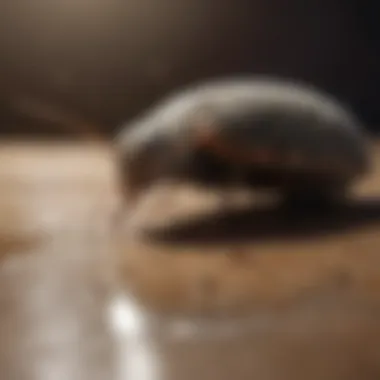Understanding Orkin Exclusion: Pest Management Insights


Intro
Pest management is a crucial aspect of maintaining a healthy home. Understanding the role of exclusion techniques is particularly important in effective pest control. Exclusion is the process of preventing pests from entering your home, which is vital for sustaining a pest-free environment. This guide will cover various exclusion methods utilized by Orkin, their significance, and how they benefit homeowners. With a focus on eco-friendly practices, this article aims to dispel common misconceptions and promote a proactive approach to pest management.
Understanding the Pest
Identification
To successfully exclude pests, one must first understand what they are dealing with. Accurate identification of pests is essential. Whether it's rodents, insects, or other unwanted creatures, knowing their species aids in determining the best exclusion strategies. Some common household pests include:
- Ants
- Cockroaches
- Rodents
- Spiders
Each pest has unique traits and behaviors, which assist in devising tailored exclusion methods.
Life Cycle
Understanding a pest's life cycle gives insight into its reproductive habits and seasonal activity. Most pests have distinct growth stages that can be exploited for effective control. For example, knowing when a pest is most active allows homeowners to fortify their exclusion measures. Unwanted critters tend to enter homes in search of food and shelter, making understanding their cycles key for effective pest management.
Pest Prevention Strategies
Environment Modification
Creating an environment that discourages pest activity is an effective strategy. This includes:
- Decluttering: Keep areas tidy to reduce hiding spots.
- Proper Storage: Use airtight containers for food and waste.
- Moisture Control: Fix leaks and ensure proper drainage to eliminate water sources.
By eliminating conducive conditions, homeowners can greatly reduce the likelihood of pest infestations.
Physical Barriers
Physical barriers are among the most straightforward exclusion methods. Some key tactics include:
- Sealing Cracks and Holes: Use caulk or foam to seal gaps in walls, foundations, and around pipes.
- Screens on Windows and Vents: Install mesh screens to keep pests out while allowing air circulation.
- Door Sweeps: Attach door sweeps to the bottom of exterior doors to combat entry from rodents and insects.
Implementing these preventive measures helps create a solid defense against unwanted intruders.
Control Methods
Chemical Control
Chemical pest control is sometimes required, especially when infestations occur. Orkin uses specific, targeted chemical applications that are designed to limit environmental impact while effectively eliminating pests. It is crucial to follow guidelines and use products responsibly to protect humans and pets.
Biological Control
Biological control involves using natural predators or parasites to manage pest populations. This method is often more sustainable and eco-friendly. For example, introducing certain beneficial insects can help keep populations of harmful pests in check. Homeowners considering this option should consult with pest control professionals to explore appropriate biological options.
"A proactive approach to pest management goes beyond simple extermination; it involves understanding and modifying the environment."
Intro to Orkin Exclusion
Pest management is a crucial aspect for homeowners looking to maintain a healthy and safe living environment. Orkin exclusion is a vital part of this practice, focusing on proactive measures to prevent pests from entering a property. Understanding this topic is essential as it addresses not only the strategies involved but also their long-term benefits.
Definition and Importance
Orkin exclusion refers to a variety of techniques aimed at keeping pests out before they become a problem. These methods emphasize prevention rather than reaction, making it an effective part of overall pest management. The importance of these exclusion techniques lies in their ability to reduce infestations and minimize the need for chemical interventions, which could have adverse effects on both health and the environment.
"Prevention is the best strategy for pest management."
Implementing exclusion methods can significantly reduce the chances of pests like rodents, insects, and other harmful organisms from invading your home. Often, when an infestation occurs, it leads to extensive damage, health risks, and costly eradication processes. By focusing on exclusion, homeowners can maintain a pest-free environment more efficiently.
Overview of Pest Exclusion Techniques
Pest exclusion techniques can be classified into various categories. Understanding these methods enables homeowners to choose the right strategies for their specific situation.
- Physical Barriers: This includes sealing cracks and crevices, installing screens on windows, and utilizing door sweeps to prevent entry.
- Environmental Modifications: Adjustments in landscape designs, moisture control, and debris removal can create an inhospitable environment for pests.
Some advanced tools and technologies complement these basic exclusion methods, making for more comprehensive solutions. For instance, thermal imaging software can identify heat signatures for pest activity, allowing for targeted actions that significantly reduce pest problems.
In the upcoming sections, we will delve deeper into the science behind exclusion, providing clarity on pest behavior and biology. This information will further solidify the foundation upon which exclusion techniques rely.
The Science Behind Exclusion
The science behind exclusion plays a pivotal role in effective pest management strategies like those offered by Orkin. Understanding the mechanisms that drive pest behavior and the biological traits of common pests is fundamental. These concepts not only aid in preventing infestations but also build a sustainable approach to pest control. By focusing on these scientific principles, homeowners can create an optimized environment that mitigates the risk of pest-related issues.


Understanding Pest Behavior
Pest behavior significantly influences how they enter and thrive in a particular environment. Each type of pest exhibits unique habits that often dictate their attractiveness to homes. For instance, rodents like mice and rats seek shelter in warm, secure areas. This makes basements, attics, and wall cavities prime locations for nesting.
Moreover, pests often follow established pathways or routes. Recognizing these pathways allows homeowners to effectively identify potential problem areas. Additionally, pests are drawn to resources like food, water, and shelter. Ensuring that the home is less appealing can disrupt their patterns of behavior.
Some key behaviors to consider include:
- Nesting Sites: Pests often choose locations that are hidden and accessible.
- Feeding Preferences: Understanding what pests eat can help in creating deterrents.
- Mating Patterns: Knowing when pests breed allows for targeted prevention measures.
Utilizing this knowledge enables the implementation of targeted exclusion strategies, preventing pests before they take residence.
Biology of Common Pests
The biological traits of pests provide insight into their vulnerabilities, helping homeowners in exclusion strategies. Common pests like cockroaches, ants, and termites display unique characteristics that inform effective management.
Cockroaches, for example, are nocturnal and prefer dark, moist environments. Their ability to reproduce rapidly means that even a small infestation can become a significant problem if not addressed quickly. Understanding their life cycle can help in timing exclusion efforts.
Ants, on the other hand, operate in colonies. They communicate through pheromones, marking pathways to food sources. Disrupting these trails can hinder their access and eliminate entire colonies over time.
Termites feed on cellulose, which is found in wood products. Recognizing their biology aids homeowners in taking preventative steps such as maintaining a moisture-free environment and using treated wood.
This examination of biological traits establishes a foundation for exclusion methods. By leveraging these concepts, individuals can effectively prevent pests from encroaching on their living spaces.
Principles of Exclusion in Pest Control
Exclusion is a fundamental concept in pest control, emphasizing the importance of preventing pests from entering a structure in the first place. Implementing exclusion strategies not only reduces the likelihood of pest infestations but also enhances the overall health and safety of indoor environments. Key considerations include the structural integrity of buildings, the behavior patterns of pests, and the ecological implications of pest management methods.
Effective exclusion relies on multiple techniques that create physical barriers and modify the surrounding environment. These tactics help safeguard homes and businesses from the various issues pests can cause. Additionally, a focus on exclusion promotes a more sustainable approach to pest control, aligning with modern practices that prioritize long-term solutions over reactive measures.
Physical Barriers
Sealing Entry Points
A crucial aspect of sealing entry points is its effectiveness in blocking pathways that pests utilize to invade spaces. This involves identifying and closing gaps, cracks, and holes in structures, such as around doors, windows, and utility connections. The main characteristic of sealing entry points is that it not only prevents pests from entering but also restricts their movement within the area. This is a popular choice because it is often a one-time solution that provides lasting results.
The unique feature of sealing entry points is its versatility. Sealants like caulk, expanding foam, or mesh screens are readily available and can be applied to various surfaces. The advantages include minimal cost and effort while significantly reducing the chances of infestation. However, a disadvantage can be the need for regular inspections, as materials may wear out over time and require maintenance to remain effective.
Using Screens and Covers
Using screens and covers represents another vital exclusion technique, primarily focusing on ventilation areas. Screens are commonly deployed on windows, doors, and vents to block insect entry while allowing airflow. The key characteristic of this method is its dual function of maintaining comfort indoors while serving as a physical barrier against pests. It is often a beneficial choice because it provides an unobtrusive layer of protection.
The unique feature of screens and covers is their ability to be customized to fit various openings, ensuring maximum effectiveness for different property layouts. One of the advantages is affordability and ease of installation, making it accessible for many homeowners. On the downside, less maintenance can lead to wear and tear, reducing their efficacy over time. Regular cleaning and checking for damage are essential to uphold the protective capabilities of screens and covers.
Environmental Modifications
Landscaping Strategies
Landscaping strategies in pest exclusion focus on modifying outdoor environments to discourage pest populations. This can include planting pest-resistant plants, maintaining proper spacing to improve airflow, and using gravel or mulch wisely. The key characteristic is that these strategies emphasize creating a naturally inhospitable habitat for pests. This offers a sustainable approach to limiting pest presence, making it a popular tactic for homes and businesses.
The unique feature of landscaping strategies is their proactive nature. These changes can enhance the aesthetic value of properties while serving pest control purposes. Advantages include improved curb appeal and increased property value. However, one challenge is that these strategies require ongoing maintenance for effectiveness, especially as seasons change and plants grow.
Moisture Management
Moisture management is another critical element of exclusion. It targets one of the primary attractants for many pests, such as rodents and insects. Proper drainage systems, gutter maintenance, and regular checks for leaks play a crucial role. The key characteristic of moisture management is its ability to reduce pest attraction through environmental control. It is a beneficial choice due to its impact on the overall health of residential spaces.
The unique feature of moisture management is its connection to structural integrity, as excess moisture can lead to damage over time. Its advantages include limiting pest access while improving the indoor air quality. Notably, a disadvantage is that it may require professional assistance to identify and resolve underlying issues effectively.
"Implementing exclusion strategies can significantly impact pest control, ensuring a healthier home environment."
By focusing on principles of exclusion in pest control, homeowners can take a comprehensive approach to safeguarding their properties. By understanding these fundamental concepts and implementing them correctly, it is possible to minimize pest risks while promoting a sustainable environment.
Advanced Orkin Exclusion Techniques
Advanced Orkin exclusion techniques play a vital role in pest management. They go beyond basic methods to include innovative solutions and strategies. The essence of these techniques lies in their ability to provide more effective barriers against pests while minimizing the impact on the environment. These approaches are essential for creating a lasting pest-free environment, especially for home and property owners who seek to protect their spaces from potential infestations.
Innovative Tools and Technologies
In today's world, technology influences every aspect of life, including pest control. Innovative tools and technologies enhance the effectiveness of exclusion methods. For example, using advanced detection systems can identify pest activity in real time. These systems include smart traps and monitoring devices that relay information directly to pest control professionals.
Another notable advancement is the use of thermal imaging cameras. These cameras can detect temperature differences caused by pest activity. By identifying such hotspots, professionals can target their efforts more efficiently. This proactive approach not only saves time but also reduces costs for property owners who wish to remain pest-free.


Using these tools enables a more meticulous inspection of premises. Homeowners can benefit from regular updates on pest potential, allowing timely interventions. This innovation is particularly important because it supports a shift towards solutions that are less invasive yet more effective.
Integration with Integrated Pest Management (IPM)
Integrating exclusion techniques with Integrated Pest Management (IPM) represents a holistic approach to pest control. IPM emphasizes the combination of various strategies to manage pests effectively. This includes biological controls, cultural practices, and habitat manipulation alongside exclusion techniques.
The benefit of this integration is significant. It provides a comprehensive framework that does not solely rely on chemical interventions. For instance, property owners can create environments less conducive to pests while employing physical barriers to keep them out. Such strategies often yield long-term results, reducing reliance on pesticides over time.
IPM also encourages education and awareness among homeowners. Understanding the biology and behavior of pests allows individuals to make informed decisions. Furthermore, by utilizing regular inspections and adopting a proactive stance, residents can maintain the integrity of their spaces without compromising safety or health.
"In pest control, proactive strategies prove to be more efficient than reactive measures. Integrating exclusion with IPM is not just a choice; it's essential for sustainable pest management."
Overall, Advanced Orkin exclusion techniques mark a significant evolution in pest control. They not only incorporate innovative technology but also align with sustainable practices. Homeowners must recognize the importance of these strategies both for immediate results and for fostering long-term pest management solutions.
The Role of Maintenance in Exclusion
Maintaining pest exclusion measures is critical for achieving long-term success in pest management. Regular maintenance helps to ensure that the protective barriers in place remain effective against unwanted intruders. Homeowners should understand that maintaining a pest-free environment is not a one-time effort, but rather an ongoing process.
The importance of maintenance in exclusion can be summarized in several points:
- Prevent Erosion of Barriers: Weather, wear, and other factors can deteriorate physical barriers over time. If not properly maintained, pests can find vulnerabilities.
- Early Detection of Issues: Routine checks can help identify potential problems before they escalate. Observing changes can prevent infestations.
- Adapting to New Threats: As pest behaviors evolve, the strategies for exclusion need to adapt as well. Regular evaluations allow for timely adjustments to methods.
In consideration of these points, it’s beneficial for homeowners to be proactive and systematic in their approach to pest exclusion maintenance.
Regular Inspections
Regular inspections are a cornerstone of effective maintenance in pest exclusion. They provide an opportunity to assess the integrity of barriers, evaluate pest activity, and identify new entry points that may have developed.
During inspections, consider the following:
- Frequency: Schedule inspections at least bi-annually or more often if you live in areas prone to infestations.
- Visual Checks: Look for signs of pests, such as droppings or gnaw marks, along with checking seals and gaps in your home.
- Professional Input: Engaging pest control professionals for thorough inspections can uncover issues that may not be visible to the untrained eye.
Regular inspections contribute to a pest-free environment by ensuring that any potential issues are addressed swiftly.
Ongoing Repairs and Adjustments
Ongoing repairs and adjustments are necessary to uphold the effectiveness of exclusion strategies. With time and environmental factors, the materials used in exclusion methods may degrade or become ineffective.
Homeowners should take proactive measures such as:
- Sealing Gaps: Regularly check existing seals around windows, doors, and utility entry points. Repair any cracks promptly.
- Updating Barriers: Replace old screens, uneven door thresholds, and damaged covers to maintain robust barriers against pests.
- Adapting Strategies: Stay informed about changes in pest activity in your area and adjust your strategies accordingly. For example, if certain pests become prevalent, additional barriers might be needed.
Maintaining a diligent routine around repairs and adjustments leads to sustainable exclusion efforts and fosters a healthy living environment.
"Prevention is better than cure. Regular maintenance can save you from future infestations."
Common Misconceptions About Exclusion
Understanding the common misconceptions about exclusion is essential for homeowners and housewives who seek effective pest management. Many people equate exclusion with eradication, leading to confusion about the actual methodology and desired outcomes. Recognizing these misunderstandings fosters a more informed approach to pest control, enhancing the overall efficacy of implemented strategies.
Exclusion vs. Eradication
A key misconception lies in the belief that exclusion and eradication are interchangeable terms. Exclusion refers to the strategies involved in preventing pests from entering a space, while eradication deals with the removal of existing pest populations.
Exclusion is a proactive approach. It entails actions such as sealing cracks, installing screens, and ensuring that entry points are secure. This method aims to create a barrier, preventing pests from accessing homes and establishments. On the other hand, eradication is often reactive. It typically involves treatments to eliminate pests that have already infiltrated.
For homeowners, understanding this distinction is vital. It clarifies that to maintain a pest-free environment, they must prioritize exclusion strategies rather than relying solely on eradication methods. Both are crucial, but they serve different purposes in pest management.
Cost vs. Effectiveness
Another common misconception is the belief that exclusion methods are costlier than conventional pest control, thus leading to skepticism about their effectiveness. It is important to break down this notion because upfront costs may seem high, but the long-term savings can be significant.
Considerations include:
- Initial Investment: Exclusion methods may require a higher initial expenditure for materials and professional services.
- Long-Term Savings: Proper exclusion can prevent infestations, which frequently lead to costlier eradication procedures and potential property damage.
- Sustainability: Exclusion promotes eco-friendly pest management solutions, which can be less harmful to the environment compared to chemical treatments.
Homeowners might find that investing in exclusion strategies enhances the effectiveness of their pest management plan. Thus, while the perception of cost may overshadow actual value, the effectiveness of exclusion should not be underestimated. It presents a sound strategy for avoiding future infestation challenges.
"While eradication might provide immediate relief, it's the exclusion that lays the groundwork for sustainable pest control."


Benefits of a Proactive Exclusion Strategy
A proactive exclusion strategy is essential in pest management, especially for homeowners seeking to safeguard their living spaces. By focusing on prevention instead of reaction, one can create a more effective approach against pest invasions. This section will explore the key aspects and advantages of adopting a proactive exclusion mindset.
Long-term Pest Prevention
Long-term pest prevention is a fundamental component of a proactive exclusion strategy. It involves anticipating potential pest issues before they become serious infestations. Here are some key considerations:
- Early Detection: Continuous monitoring for signs of infestations allows for timely intervention. Implementing regular inspections helps to catch small issues before they grow.
- Durability of Solutions: Proactively sealing entry points and using physical barriers ensures that pests cannot easily access your home. This could include repairing cracks, installing door sweeps, and using screens on windows.
- Education and Awareness: Homeowners can benefit from understanding pest behavior. Knowledge of how pests enter homes and where they hide empowers residents to take preventative measures.
- Cost-Effectiveness: Addressing pest issues before they escalate saves money in potential extermination costs. A small upfront investment in exclusion techniques often leads to significant long-term savings.
By committing to long-term pest prevention, homeowners can enjoy peace of mind, knowing they have taken steps to protect their properties from harm.
Eco-friendly Pest Management Solutions
Another crucial benefit of a proactive exclusion strategy is its alignment with eco-friendly pest management solutions. Many traditional pest control methods rely on harmful chemicals. In contrast, exclusion techniques focus on natural or less invasive options to deter pests.
- Natural Barriers: Simple changes, such as using diatomaceous earth or essential oils, can deter insects without the risks associated with pesticides.
- Sustainable Practices: Maintaining a clean environment, such as proper waste disposal and landscaping choices, reduces the attractants that bring pests into homes.
- Reducing Chemical Usage: By prioritizing exclusion over extermination, homeowners can significantly reduce the need for chemical treatments, leading to safer indoor air quality and environmental protection.
"A proactive approach to pest management emphasizes prevention, sustainability, and responsiveness, avoiding reliance on harsh chemicals that can harm both occupants and the environment."
Case Studies in Successful Exclusion
Analyzing case studies in successful exclusion offers valuable insights into effective pest management strategies. These studies illustrate real-world applications of exclusion methods and their results. Learning from both residential and commercial implementations can inform homeowners about best practices and push them toward proactive pest prevention. Moreover, it highlights the significance of tailored approaches based on specific environments and pest challenges.
When reviewing these case studies, it is crucial to focus on outcomes achieved, the techniques utilized, and any challenges encountered. This not only enriches the understanding of exclusion methods but also emphasizes the need for continuous adaptation and innovation in pest management.
"Success in pest management is never merely about eradication; it's about creating an environment that pests can't thrive in."
Residential Implementations
Residential implementations of exclusion strategies have shown remarkable success in preventing invader pests from compromising home safety and comfort. For instance, a case study in dense suburban areas illustrates how strategic sealing of entry points—such as around windows, doors, and vents—had a significant impact on reducing pest activity. In one specific home, the owners noticed dramatic improvements after utilizing weather stripping and caulking.
In addition, maintaining a tidy yard by trimming trees and shrubs away from the house was shown to deter pests like ants and spiders. Homeowners also engaged in regular inspections and discovered leaks that led to moisture accumulation, a common attractant for pests. By fixing these leaks and managing debris, they minimized risks.
Key takeaways from this study include:
- Sealing Entry Points: Eliminating gaps can significantly reduce pest entry.
- Regular Yard Maintenance: Keeping the premises clear of potential nesting sites boosts exclusion efforts.
Commercial Applications
Commercial applications of exclusion methods also have notable case studies demonstrating their effectiveness. For instance, a popular restaurant chain adopted comprehensive exclusion strategies by focusing on their supply chain and building structure. They installed rodent-proof barriers and improved the cleanliness of storage areas.
Regular employee training was essential, emphasizing vigilance in preventing pest activities. The establishment of a detailed monitoring plan allowed them to identify vulnerabilities quickly. It resulted in not just the elimination of existing pest issues but also prevented future infestations.
From these commercial scenarios, several principles arise:
- Robust Structural Modifications: Strong building designs form a first line of defense against pests.
- Training and Awareness: Educating employees leads to proactive monitoring and management.
These case studies serve to reinforce the significance of implementing effective exclusion measures, be it in residential or commercial settings. They showcase the practical benefits of these strategies and their implications for achieving long-term pest control solutions.
Finale: The Future of Orkin Exclusion
The conclusion of this guide serves to illuminate the ongoing evolution in pest management strategies, particularly through Orkin exclusion methods. In an era marked by growing environmental concerns and the need for sustainable practices, exclusion techniques are poised to play an even more critical role in pest management solutions. The significance of understanding these methods cannot be overstated, as they offer a path forward towards a healthier, pest-free environment.
As pest control strategies evolve, house owners must remain informed about the best practices in exclusion. This involves not only understanding the fundamental principles but also recognizing the emerging trends in the market. With effective implementation, Orkin exclusion can lead to significant cost savings over time, as homeowners will face fewer pest-related issues.
Emerging Trends in Pest Management
The landscape of pest management is continually changing, influenced by environmental expectations and technological advancements. Modern pest management is trending towards more integrated approaches that emphasize prevention as opposed to reaction. One significant trend is the increase in biological pest control methods, which utilize natural predators to manage pest populations. This minimizes the need for chemical solutions and aligns with eco-friendly practices.
Additionally, urbanization has led to the exploration of urban pest management strategies that focus on sustainable practices tailored to metropolitan areas. Homeowners should stay abreast of these trends to make informed decisions regarding pest prevention.
Key Emerging Strategies:
- Biological Control Methods: Using natural enemies of pests to naturally regulate their populations.
- Eco-Friendly Products: Increasing availability and use of non-toxic pest control products.
- Community Cohesion: Neighbors banding together for neighborhood-wide pest control efforts.
The Role of Technology in Future Exclusion Strategies
Emerging technology is becoming integral to the practice of pest exclusion. Innovations such as AI-driven detection systems and remote monitoring tools allow for precise pest activity tracking. Such technologies enhance the ability to implement preventative measures before infestations occur. Smart home devices, equipped with sensors and alerts, provide real-time information, further strengthening exclusion efforts.
Advancements also include the use of drone technology for extensive property assessments and the deployment of heat mapping strategies to identify potential pest hotspots. These tools empower homeowners to take a proactive stance against pests, optimizing exclusion efforts significantly.
Investing in technology not only improves the effectiveness of pest control strategies but also fosters a sense of empowerment among house owners. By taking an informed approach, the future of exclusion looks promising, making homes safer and more sustainable.
"The future of pest control relies heavily on prevention through exclusion, which must incorporate the latest technology and ecological awareness."
In summation, understanding Orkin exclusion not only enhances individual pest management efforts but also contributes to broader ecological benefits. As homeowners embrace these practices and stay updated on trends and technology, they ensure a more pest-resistant future.







